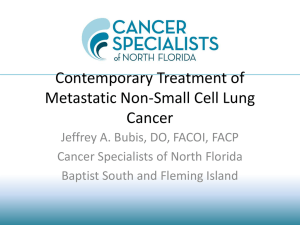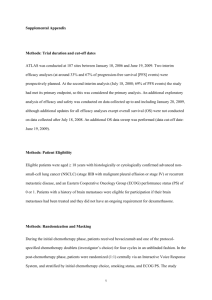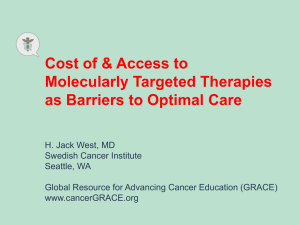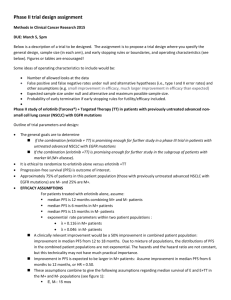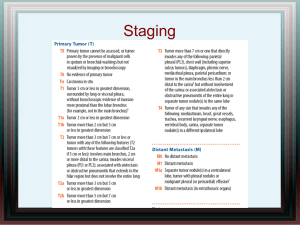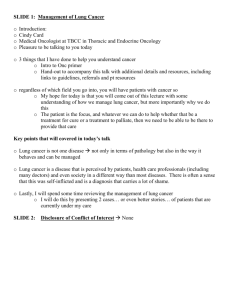EGFR Mutation
advertisement
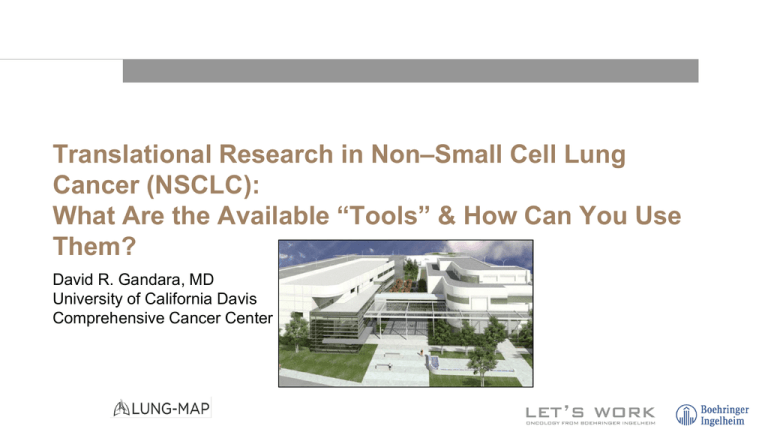
Translational Research in Non–Small Cell Lung Cancer (NSCLC): What Are the Available “Tools” & How Can You Use Them? David R. Gandara, MD University of California Davis Comprehensive Cancer Center 1 Available “Tools” for Translational Research in NSCLC: Interaction of Pathology, “Omics,” and Immuno-Biology From “All Patients Are the Same” From Histology to Prognostic and/or Predictive Biomarkers to Inter- and Intra-Patient Heterogeneity in Tumour Biology & Immuno-Biology Translational Research Personalised Therapy for Individual Patients With NSCLC Adapted from Gandara et al. Clin Lung Cancer. 2012. 2 Moving From Histologic Classification to Molecular Classification of NSCLC Patients Into Prognostic or Predictive Subgroups for Therapy • Histologic subtyping groups tumours based on microscopic pattern recognition by a pathologist • At best, Histology = “crude molecular selection” EGFR Mutation Positive ALK FISH 3 Evolution of NSCLC Subtyping From Histologic to Molecular-Based NSCLC as one disease First Targeted Therapies in NSCLC ALK EGFR Li, Mack, Gandara et al. JCO. 2013 (adapted from Pao et al). 4 Magnitude of Genomic Derangement Is Greatest in Lung Cancer n=109 81 64 38 316 100 17 82 Mutations Per Mb DNA 28 119 21 40 20 Carcinogen-induced Cancers 100 / Mb 10 / Mb Hematologic & Childhood Cancers Ovarian, Breast, Prostate Cancers 0.1 / Mb Squamous Adenoma 1 / Mb ?? Adapted from The Cancer Genome Atlas Project: Govindan & Kondath et al. Nature. 2013. 5 Lung Cancer Complexity on an Individual Patient Basis: Squamous-Cell Lung Cancer Examples (“Circos”) LUSC-66-2756 LUSC-34-2600 LUSC-56-1622 LUSC-60-2695 LUSC-43-3394 LUSC-60-2711 LUSC-34-2609 LUSC-60-2713 From Ramaswamy Govindan. TCGA (The Cancer Genome Atlas). 6 Integration of Biomarkers Into Clinical Practice: Past, Current & Future Empiric Approach (Past) (Compound-Based Therapy): Clinical-histologic factors to select drugs for individual patients 1. Histomorphological Diagnosis: Cancerous 2. Molecular Diagnosis: Archival FFPE tumour specimens Archival cancer specimens Macro- or Micro-dissection of Tumours Extract tumour nucleic acids: DNA and RNA Representative technologies: Current Approach (Target-Based Therapy V1.0): Single gene molecular testing for decision-making in individual patients Evolving Approach (Target-Based Therapy V2.0): Multiplexed molecular tests with increased sensitivity & output for decision-making in individual patients Near-Future Approach (Patient-Based Therapy): Genomic profiling by high throughput next generation sequencing for decision-making in individual patients From Li, Gandara et al. JCO. 2013. Plasma cfDNA by NGS Single Biomarker Tests: • Sanger DNA Sequencing • RT-PCR • FISH • IHC Multiplex, Hot Spot Mutation Tests: • PCR-based SNaPshot • PCR-based Mass Array SNP • Sequenom Initial High-Throughput Technologies: • SNP/CNV DNA microarray • RNA microarray Next-Generation Sequencing (NGS): • Whole Genome or Exome Capture Sequencing (DNA) • Whole or Targeted Transcriptome Sequencing (RNA) • Epigenetic profiling 7 Comprehensive Cancer Genomic Test: 200+ Genes Foundation Medicine One <14 days 8 Guardant360 Panel 2015: Plasma NGS Complete* or Critical Exon Coverage in 68 Genes Point Mutations Amplifications Fusions Indels AKT1 ALK APC AR AR ALK EGFR exon 19 deletions AFAR ARID1A ATM BRAF BRAF RET EGFR exon 20 insertions BRCA1 BRCA2 CCDN1 CCND2 CCNE1 ROS1 CCNE1 CDH1 CDK4 CDK6 CDK4 NTRK1 CDKN2A CDKN2B CTNNB1 EGFR CDK8 ERBB2 ESR1 EZH2 FBXW7 EGFR FGFR1 FGFR2 FGFR3 GATA3 ERBB2 GNA11 GNAQ GNAS HNF1A FGFR1 HRAS IDH1 IDH2 JAK2 FGFR2 JAK3 KIT KRAS MAP2K1 KIT MAP2K2 MET MLH1 MPL KRAS MYC NF1 NFE2L2 NOTCH1 MET NPM1 NRAS NTRK1 PDGFRA MYC PIK3CA PTEN PTPN11 RAF1 PDGFRA RET RHEB RHOA RIT1 PIK3CA ROS1 SMAD4 SMO SRC RAF1 STK11 TERT** TP53 VHL *Complete exon coverage for genes in bold; **Includes TERT promoter region. 9 Available “Tools” for Translational Research in Advanced NSCLC “Targeted Therapy” Chemotherapy Histologic Subtyping for Chemotherapy ? Targeted Nintedinib? Necitumumab? Ramucirumab? Checkpoint Immunotherapy Anti-PD-1 and PD-L1 Anti-CTLA-4 Targeted TKIs: -EGFR -ALK -ROS1 Translational Research Opportunities: How do we optimize use of these “tools” (therapeutic modalities) in order to create new treatment paradigms? Targeted Therapies in Oncogene-Driven NSCLC: De Novo & Acquired Resistance • Targeted Therapies against Oncogene-Driven Cancers, EGFR mutation+ (erlotinib) or ALKfusion+ (crizotinib), improve response and PFS when compared with chemotherapy • Even in these most sensitive cancers, approximately 25% to 40% do not respond to TKI therapy (de novo resistance) • Even in these most-sensitive cancers, acquired resistance is universal, with PFS averaging ≈10-14 months Oncogene-driven NSCLC Gandara, Redman et al. Clin Lung Cancer. 2014. 11 Evolutionary Biology & Acquired Tumour Resistance • Intra-tumour heterogeneity is present at baseline (scenarios 1 & 2) Scenario 1 Scenario 2 “Driver” Oncogene “Driver” Oncogene Evolution over time with therapy Evolution over time with therapy New “Driver” New “Driver” • Reducing sensitive clones by therapy permits unopposed growth of less fit resistant clones or emergence of a new clone (“Tumour Darwinism”) • Separating “new drivers” from “passengers” is complex • This process is dynamic, not static • Original sensitive clone is still present ]. at time of resistance Original Sensitive Clone Adapted from Gandara et al. Clin Lung Cancer. 2012. 12 Available “Tools” for Translational Research: Re-Biopsy to Assess Tumour Evolution Referring Physician Identify Patient Pathologist Multidisciplinary Team (Tumour Board) Identify Target Lesion Med Oncologist Thoracic Surgeon Radiation Oncologist Pulmonologist Radiologist Pathologist Pulmonologist Interventional Radiologist Surgeon Histology Evaluation Determine Therapy Biopsy Molecular Biomarker Testing When Progression Re-Biopsy Oncologist T r e a t Determine New Therapy Treat When Progression Re-Biopsy Adapted from: Gandara. ASTRO/ASCO/IASLC Symposium on Molecular Testing, 2012. 13 Emergence of ALK Resistance Mechanisms After Crizotinib • • • • Secondary resistance ALK mutations ALK gene copy number increase Transition to EGFR mutation Transition to KRAS mutation Consistent with mathematical models of evolutionary biology Doeble, Camidge et al. CCR. 2012. 14 Schema for Multidisciplinary Integration of Biomarker Testing in Advanced-Stage NSCLC: Looking for “Actionable” Oncogenes Referring Physician Identify Patient Pathologist Multidisciplinary Team (Tumour Board) Identify Target Lesion Med Oncologist Thoracic Surgeon Radiation Oncologist Pulmonologist Radiologist Pathologist Pulmonologist Interventional Radiologist Surgeon Histology Evaluation Determine Therapy Biopsy Molecular Biomarker Testing When Progression Re-Biopsy Plasma cfDNA Oncologist T r e a t Determine New Therapy Treat When Progression Re-Biopsy Plasma cfDNA Adapted from: Gandara. ASTRO/ASCO/IASLC Symposium on Molecular Testing, 2012. 15 Association Between pEGFR mut+ at C3 and PFS/OS (Both Treatment Arms Combined) PFS OS C3 mut+ C3 mut+ C3 mut– C3 mut– PFS probability 0.8 0.6 0.4 0.2 0.8 0.6 0.4 0.2 7.2 12.0 0 0 0 2 4 6 8 10 12 14 16 18 20 22 24 26 28 30 32 42 42 35 28 14 7 6 4 1 1 1 1 0 0 0 80 80 77 65 59 47 40 34 32 28 23 19 13 10 7 18.2 31.9 0 2 4 6 8 10 12 14 16 18 20 22 24 26 28 30 32 34 36 Time (months) Patients, n C3 mut+ C3 mut– Median = 18.2 months (95% CI: 14.2–27.4) Median= 31.9 months (95% CI: 23.5–undefined) HR = 0.51 (95% CI: 0.31–0.84); P=0.0066 1.0 OS probability Median = 7.2 months (95% CI: 6.0–7.8) Median =1 2.0 months (95% CI: 9.6–16.5) HR = 0.32 (95% CI: 0.21–0.48); P<0.0001 1.0 Time (months) 0 3 0 0 Patients, n C3 mut+ C3 mut– 42 42 42 41 37 32 30 28 23 21 18 14 14 12 9 4 3 2 0 80 80 80 77 77 77 76 71 68 64 59 52 38 29 22 12 3 1 0 Mok et al. WCLC 2013. 16 Approaches to Acquired Resistance in Oncogene-driven Cancers (EGFR MT & ALK Fusion) Systemic-PD Advanced NSCLC With Oncogene-driven Cancer Targeted TKI -EGFR Mutation -ALK Fusion Switch Therapy: Chemotherapy or 2nd/3rd gen TKI RECIST Response Subsequent Systemic PD Continue same TKI alone (post-progressive disease) Add Therapy to TKI -Chemotherapy ? -Another Targeted Agent? Re-biopsy Gandara et al. Clin Lung Cancer. 2014. 17 IMPRESS: Phase III Trial of Post-progression Gefitinib/Chemotherapy vs Chemotherapy Alone in EGFR Mutation–Positive NSCLC After Prior Response (Acquired Resistance) Gefitinib 250 mg + cisplatin + pemetrexed up to 6 cycles (n=133) • Stage IIIB/IV NSCLC • EGFR mutation positive • WHO PS 0–1 • Prior response* to 1st-line gefitinib PD • PD <4 weeks prior to study (n=265) R PD Primary endpoint: PFS 1:1 Placebo + cisplatin + pemetrexed up to 6 cycles (n=132) PD Secondary endpoints • OS, ORR, DCR • Safety and tolerability, health-related QoL *CR/PR ≥4 months or SD >6 months. Mok et al. ESMO-Ann Oncol. 2014;25(suppl 4): abstr LBA2_PR. 18 IMPRESS: Phase III Trial of Post-progression Gefitinib/Chemotherapy vs Chemotherapy Alone in EGFR Mutation–Positive NSCLC After Prior Response (Acquired Resistance) PFS (primary endpoint; ITT) OS (ITT; 33% of events) Gefitinib (n=133) Placebo (n=132) 5.4 5.4 Median PFS, months Response: Number of events, n (%) 34% 0.9 0.9 0.8 0.8 0.7 0.7 0.6 0.5 0.4 0.3 0.2 14.8 17.2 50 (37.6) 37 (28.0) HRa (95% CI) = 1.62 (1.05, 2.52); p=0.029 1.0 Probability of PFS Probability of PFS 32% Placebo (n=132) Median OS, months HRa (95% CI) = 0.86 (0.65, 1.13); p=0.273 1.0 Gefitinib (n=133) 0.6 0.5 0.4 0.3 0.2 Gefitinib (n=133) 0.1 0 0 2 4 Gefitinib (n=133) 0.1 Placebo (n=132) Placebo (n=132) 0 6 8 10 12 14 0 2 4 Time of randomisation (months) Patients at risk: Gefitinib 133 Placebo 132 110 100 88 85 40 39 25 17 12 5 6 8 10 12 14 16 18 20 22 24 26 2 4 0 2 0 0 Time of randomisation (months) 6 4 0 0 Patients at risk: Gefitinib 133 Placebo 132 125 129 111 119 88 94 64 76 43 55 27 39 19 27 12 16 8 10 4 7 Mok et al. ESMO-Ann Oncol. 2014;25(suppl 4): Abstract LBA2_PR. 19 Mechanisms of EGFR TKI Resistance (Selected) • Secondary EGFR mutation (ie, T790m) 2nd Gen EGFR TKIs ie, Afatinib Afatinib/Cetuximab rd 3 Gen- AZ9291, CO1686 • Bypass signaling via ERBB3 Anti-ERBB3 drugs ie, MM151 MoAB • MET over-expression MET Inhibitors ie, MET-Mab (MoAB) ARQ197 (TKI) • PIK3CA Mutation/AKT ie, BKM120 (PIK3CA) ie, MK2206 (AKT) & Others HSP inhibitors ie, Ganetespib AUY922 Adapted from Engelman et al. 20 Best Response in EGFR-Mutated T790M+ Cancers CO-1686 (Sequist: Targ Tx 2015) AZD9291 (Jänne: Targ Tx 2015) 21 22 ETCTN Project Team Proposals: AZD9291 in EGFR-mutated NSCLC Post-progression After Erlotinib 23 Clinical Trial Designs to Address Circumvention of Acquired Resistance in Oncogene-Driven NSCLC Prolongation of Remission (delay time to PD) Oncogene-driven NSCLC Targeted TKI Monotherapy (Standard of Care) Biopsy AdvancedStage NSCLC Identification of Driver Oncogene EGFR Mutation Targeted TKI Monotherapy (2nd-Generation Agent) Multi-drug Targeted Therapy Gandara et al. Clin Lung Cancer. 2014. 24 Phase II/III Trial of Afatinib With or Without Cetuximab in 1st-Line Therapy of EGFR-mutated NSCLC (S1403) Stage IIIB-IV NSCLC with EGFR mutation 1st Line EGFR TKI naive R A N D O M I S A T I O N Afatinib* Afatinib + Cetuximab* *at PD: Biopsy for genomic study & PDX development (selected patients) PD: progressive disease PDX: patient-derived xenograft PIs: Goldberg, Lilenbaum, Politi. 25 Modulator Effects of EGFR MoAB Cetuximab: Afatinib (BIBW) + Cetuximab in EGFR T790M+ GEMMs Pretreatment Cetuximab H Cetux/BIBW H H Pretreatment BIBW H Cetux/BIBW H H C Control N T1 T2 T1 T2 B T1 T2 B+C T1 T2 pEGFR tEGFR Regales et al. J Clin Invest. 2009. Actin 26 Afatinib + Cetuximab in EGFR-mutated NSCLC Refractory to EGFR TKI Response rate: ≈30% Clinical benefit (DCR): 75% Janjigian, Pao et al. Cancer Discovery. 2014;4:1036-1045. 27 Phase II/III Trial of Afatinib With or Without Cetuximab in 1st-Line Therapy of EGFR-mutated NSCLC (S1403) Stage IIIB-IV NSCLC with EGFR mutation 1st Line EGFR TKI naive R A N D O M I S A T I O N Afatinib* Afatinib + Cetuximab* *at PD: Biopsy for genomic study & PDX development (selected patients) PD: progressive disease PDX: patient-derived xenograft PIs: Goldberg, Lilenbaum, Politi. 28 Strategies for Integrating Biomarkers Into Clinical Trial Designs for NSCLC When Viewed as a Multitude of Genomic Subsets Evolution of NSCLC Histologic Subsets Genomic Subsets Unmet needs addressed by master protocols: • How to develop drugs for uncommon-rare genotypes? • How to apply broad-based screening (NGS)? • How to achieve acceptable turnaround times for molecular testing for therapy initiation (<2 weeks)? • How to expedite the new drugbiomarker FDA approval process (companion diagnostic)? Li, Mack, Kung, Gandara. JCO. 2013. 29 “Strategies for Integrating Biomarkers Into Clinical Development of New Therapies for Lung Cancer” A Joint NCI Thoracic Malignancies Steering Committee-FDA Workshop Bethesda MD – February 2-3, 2012 • Trial Design Challenges in the Era of Biomarker-driven Trials – Innovative Statistical Designs – Challenges for Community Oncology Practice Participation – The Patient Perspective • Drug & Biomarker Co-Development in Lung Cancer – Need for Early Co-Development – Need for Improved Pre-Clinical Models With Clinical Relevance • Development of Future Lung Cancer Trials – TMSC Master Protocol Task Force in NSCLC – Biomarker-driven trial designs in both early stage adjuvant therapy & advanced-stage NSCLC – Account for inter-patient tumour heterogeneity & genomic complexity of NSCLC 30 Master Protocol Subtypes Umbrella Trials Basket Trials Single Type of Cancer: Test multiple drug-biomarker combinations Multiple Cancer Types: Test multiple drugs against single or multiple biomarkers • BATTLE • Imatinib Basket • I-SPY2 • BRAF+ • SWOG Lung MAP (S1400): adv SCCA • NCI MATCH • ALCHEMIST: early stage NSCLC • ALK Master Protocol: ALK+ NSCLC 31 ALCHEMIST Trial Schema Non-Match: Phase III trial of nivolumab vs placebo X 1 year after any adj tx (EGFR & ALK testing performed by RGI) 32 ALK Master Protocol: Proposed Trial Design Control Arm (Criz.) Control Arm (Criz.) Crizotinib ALK positive NSCLC Treatment Naïve patients Central Confirmation ALK NGS Drug A Drug B Drug C Drug A To B Drug A To C Drug A To Criz. Cross Over PD NGS PD NGS New Biopsy Drug B to A Drug B To C Drug B to Criz. Archived tissue From S Malik: NCI. Drug Criz. To A Drug Criz. To B Drug Criz. To C New Biopsy Drug C 33 Rationale for “MASTER PROTOCOL” in SCCA • SCCA represents an unmet need Therapeutic targets SCCA-TCGA 2012 • Candidate molecular targets are available from results of TCGA & other studies, identified by a biomarker • Drugs (investigational) are now available for many of these targets • Trials can be designed to allow testing & registration of multiple new drug-biomarker combinations at the same time (“MASTER PROTOCOL” concept) • Result of this concept is Lung-MAP (S1400), activated in June 2014 34 S1400 Lung-MAP Protocol: A Unique Private-Public Partnership Within the NCTN Alliance SWOG NCI-C S1400 Master Protocol ECOGAcrin NRG 35 S1400: MASTER LUNG-1: Squamous Lung Cancer — 2nd-Line Therapy CT Biomarker Profiling (NGS/CLIA) Biomarker Non-Match Multiple Phase II-III Sub-studies with Rolling Opening & Closure Biomarker A TT A CT Primary Endpoint PFS/OS Biomarker Β TT B CT Primary Endpoint PFS/OS Biomarker C TT C+CT CT Primary Endpoint PFS/OS NonMatch Drug Biomarker D TT D+E E Primary Endpoint PFS/OS TT = Targeted therapy; CT = chemotherapy (docetaxel or gemcitabine); E = erlotinib. Project Chair: V. Papadimitrakopoulou Steering Committee Chair: R. Herbst SWOG Lung Chair: D. Gandara 36 LUNG-MAP (S1400): Squamous Lung Cancer — 2nd-Line Therapy Common Broad Platform CLIA Biomarker Profiling◊ CDK4/6 M: CCND1, CCND2, CCND3, cdk4 ampl PI3K M:PIK3CA mut GDC-0032 CT Endpoint PFS/OS PD-0332991 CT Endpoint PFS/OS FGFR M: FGFR ampl, mut, fusion AZD4547 CT Non-match CT Endpoint PFS/OS Anti-PD-L1: MEDI4736 HGF M:c-Met Expr AMG102+E E Endpoint PFS/OS CT = chemotherapy (docetaxel or gemcitabine); E = erlotinib. ◊ Archival FFPE tumour, fresh CNB if needed. Project Chair: V. Papadimitrakopoulou Steering Committee Chair: R. Herbst SWOG Lung Chair: D. Gandara 37 LUNG-MAP (S1400): Squamous Lung Cancer— 2nd-Line Therapy Assign Treatment Arm by Marker Patient Registration Consent Investigational Targeted Therapy Randomisation Tumour Collection Genomic Screening (FM one) <2 weeks New Tumour Biopsy (if needed) Treatment Interim Endpoint: PFS NGS/IHC (Foundation Medicine) Primary Endpoint: OS Standard-of-Care Therapy • Organisers: NCI-TMSC, FDA, FNIH, FOCR • Participants: Entire North American Lung Intergroup (SWOG, Alliance, ECOG-Acrin, NRG, NCI-Canada) • Screening: up to 1,000 patients/year • With 4-6 arms open simultaneously, anticipate a hit rate ≈65% in matching a patient with a drug/biomarker arm 38 Squamous Lung Master Protocol Clinical Trial Assay Based on Foundation Medicine NGS Platform Foundation Medicine NGS test platform (CLIA/CAP) 1) DNA extraction Classification rules 2) Library construction: 3) Analysis pipeline selected cancer genes Illumina HiSeq 2500 4) Master protocol CTA • Based on FM T5 NGS platform • Implemented as “mask” of T5 content and classification rules on called alterations • Rules determine biomarker positive/negative status Classification rules (preliminary) Non-NGS biomarkers: Supplementary assays Non-match arm MET IHC (+) All assays (-) MET pathway inhibitor Anti-PD-L1 Ab PIK3CA mutation CCND1 amplification or CDKN2A/B deletion, and RB1 wild-type FGFR1/2/3/4 amplification, mutation or fusion PI3K inhibitor CDK4/6 inhibitor FGFR inhibitor 39 Biomarker Trial Design Based on Comprehensive Genomic Profiling 60% 50% Screen success rate: up to ≈80% of patients, depending on biomarkers selected PIK3R1/2, TSC1/2, AKT1/2 5% CCND3 amp CCNE1 amp CDK6 amp STK11 loss 46% 4% CCND2 amp 40% % of lung squamous 30% patients with alteration FBXW7 loss CCND1 amp PTEN loss 26% 26% PIK3CA amp CDKN2A/B loss 20% 10% 25% 5% PIK3CA mutation 47% 4% FGFR3 amp FGFR1 amp/ mutation 0% PI3K/AKT/mTOR lead candidate biomarkers Cell Cycle FGFR additional potential biomarkers 18% 40 What Are the Statistical Assumptions? Lung-MAP Sub-studies Phase 2 Phase 3 Approximate Time of Sample Analysis Size Approximate Time of Analysis Prevalence Estimate Approximate Sample Size 56.0% 170 GNE+ 5.6% 78 FMI+ 8.0% 152 19 400 72 S1400C 11.7% 124 11 312 45 S1400D 9.0% 112 11 302 53 S1400E 16.0% 144 9 326 37 Sub-study ID S1400A 8 380 21 S1400B 288 41 Is Lung-MAP Self-sustaining? Activation of Lung-MAP Within 1st Month (July 2014) 42 LUNG-MAP (S1400): Squamous Lung Cancer — 2nd-Line Therapy Common Broad Platform CLIA Biomarker Profiling◊ PI3K M:PIK3CA mut GDC-0032 CT Endpoint PFS/OS CDK4/6 M: CCND1, CCND2, CCND3, cdk4 ampl PD-0332991 CT Endpoint PFS/OS CT Non-match FGFR M: FGFR ampl, mut, fusion AZD4547 CT Endpoint PFS/OS Anti-PD-L1: MEDI4736 HGF M:c-Met Expr AMG102+E E Endpoint PFS/OS CT = chemotherapy (docetaxel or gemcitabine); E = erlotinib. ◊ Archival FFPE tumour, fresh CNB if needed. Project Chair: V. Papadimitrakopoulou Steering Committee Chair: R. Herbst SWOG Lung Chair: D. Gandara 43 44 Is Lung-MAP “Self-sustaining”? Lung MAP is designed to be adaptable with changes in the therapeutic landscape • Example: recent approval of nivolumab in 2nd-line therapy of squamous lung cancer – Lung MAP modified to be 2nd-line and beyond (ie, some substudies are now 2nd3rd line, others 2nd-line) – One planned immunotherapy combination substudy is 2nd- line with nivolumab control arm – Another planned substudy is 3rd-line after nivolumab PD 45 Is Lung-MAP “Self-sustaining”? • New Targets-New Opportunities – PARP – mTORC1/mTORC2 (RICTOR) – PI3K/PTEN – Wee-1 kinase – ATR – VEGFR2 – TRK – Drug combinations (Immunotherapies) Hammerman et al. Nature. 2012. 46 SUPPORTING COOPERATIVE GROUPS: ALLIANCE Everett Vokes, M.D. University of Chicago Medical Center NCIC-CTG Glenwood Goss, M.D. University of Ottawa ECOG/ACRIN Suresh Ramalingam, M.D. Emory University NRG Jeff Bradley, M.D. Washington University School of SUPPORTING COOPERATIVE GROUPS: ALLIANCE Everett Vokes, M.D. University of Chicago Medical Center NCIC-CTG Glenwood Goss, M.D. University of Ottawa ECOG/ACRIN Suresh Ramalingam, M.D. Emory University NRG Jeff Bradley, M.D. Washington University School of Medicine 47
